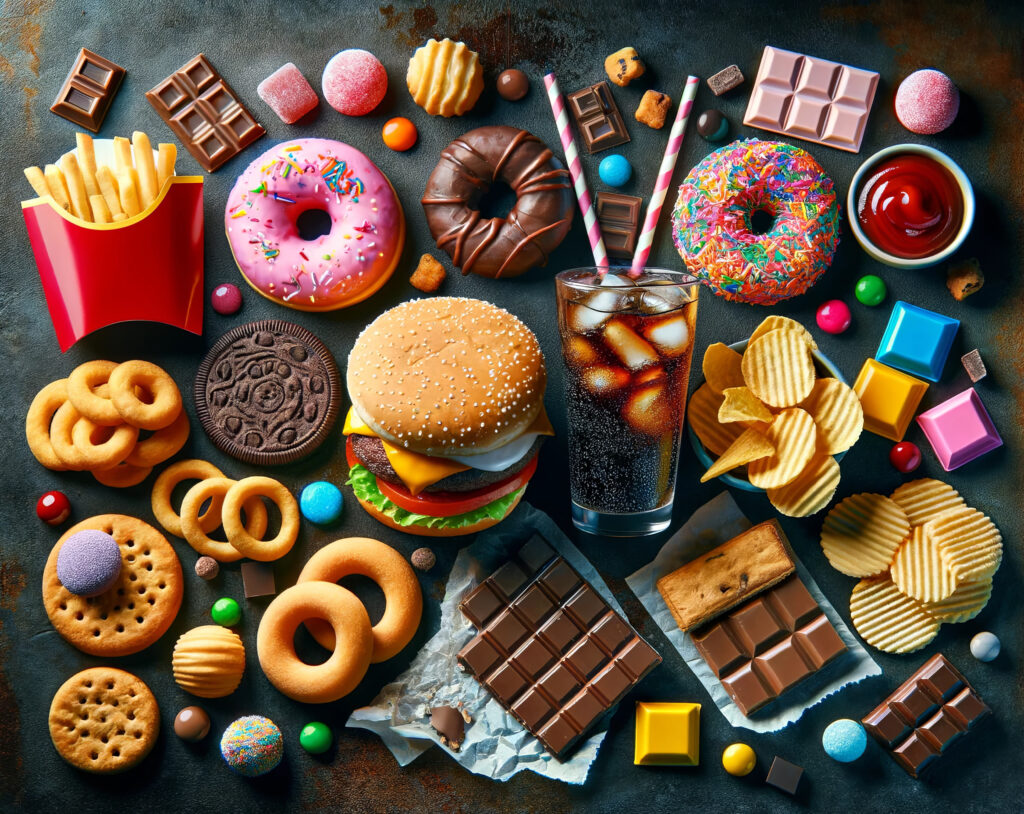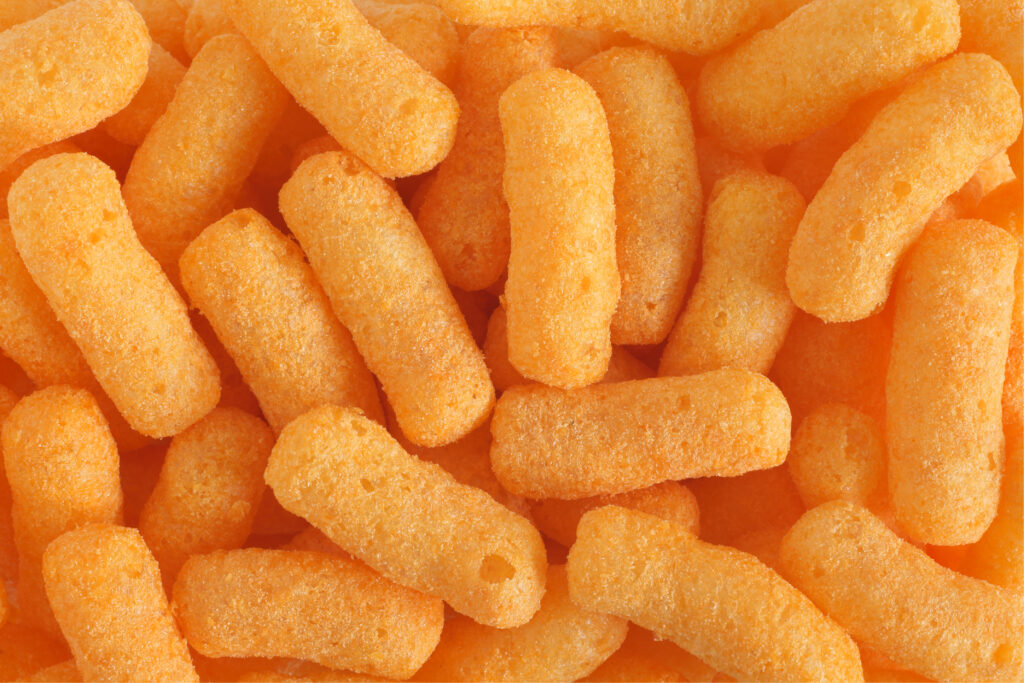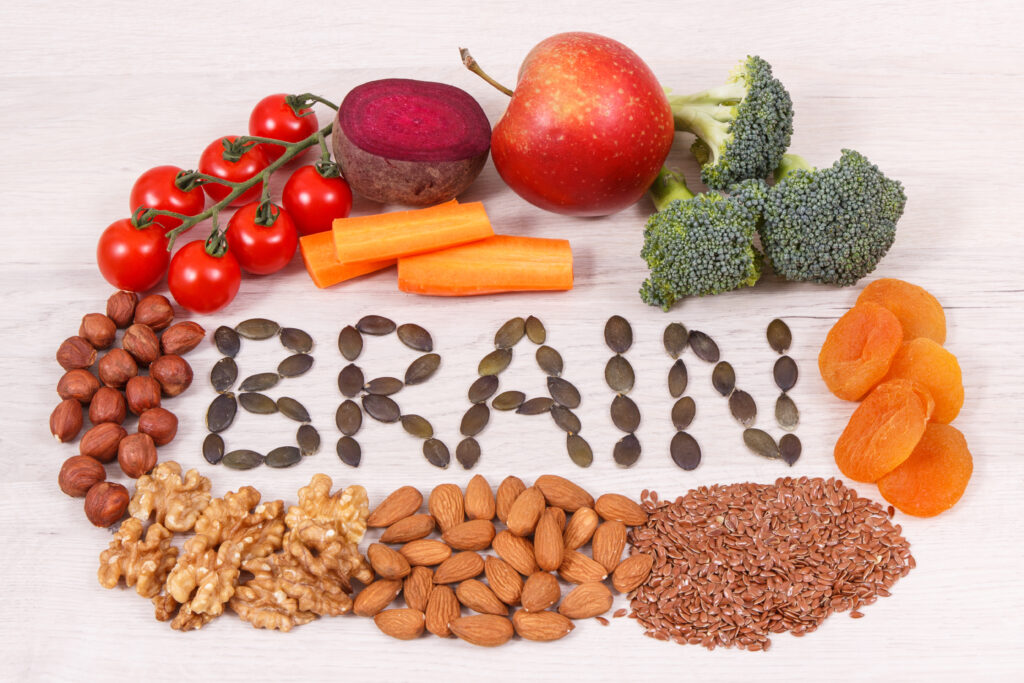blog
October 28, 2025
Ultra Processed Foods and Menopause: What You Need to Know
Ultra-processed foods (UPFs) are a hot topic in nutrition right now — linked to everything from weight gain and hormone health to heart disease and even menopause symptoms. With so much noise in the media, it’s easy to feel unsure about what’s actually okay to eat — and whether every convenience food in your kitchen is suddenly off-limits.
While eating a lot of UPFs may affect health and weight, the real story is more complex than the headlines suggest — and not all ultra-processed foods are created equal. Some can fit perfectly well into a healthy midlife diet; the key is knowing which ones are fine to include regularly and which are best eaten less often.
The reality is that most of us regularly eat UPFs — in the UK, more than half of our daily calories come from these foods. That means cutting them out completely probably isn’t realistic or even necessary. Rather than demonising UPFs, the goal is to focus on improving the overall quality of your diet — choosing more of the foods that nourish your body and fewer that don’t.

In this post, we’ll explore what the science actually says about ultra-processed foods and menopause — how UPFs may influence weight, wellbeing, and common menopause symptoms— and share simple, realistic ways to eat less UPF’s without giving up convenience or spiralling into guilt or confusion.
Because conversations about food in midlife should bring clarity and confidence, not fear.
What Are Ultra-Processed Foods (UPFs)?
If you’re not 100% sure what an ultra-processed food is, you’re not alone. The term is everywhere right now — but it can be confusing and is often misunderstood.
You might be hearing:
- “Avoid anything in a packet”
- “If you can’t pronounce the ingredients, don’t eat it”
- “Ultra-processed = toxic”
But the truth is far more nuanced.
Ultra-processed foods (UPFs) are products that have gone through multiple stages of factory processing, with few wholefoods and often include ingredients you wouldn’t typically use in home cooking — like flavour enhancers, colourings, emulsifiers, or artificial sweeteners. They’re made to taste good, last longer, and make life easier — which is why they’ve become such a big part of modern eating, especially when time is short.
Factory processing might include refining grains into fine white flour, adding emulsifiers to keep a product smooth (as in flavoured yoghurts), or using stabilisers and flavourings to make foods last longer — think crisps, or ready meals.

The NOVA system
This is the framework used to decide whether a food is ultra-processed — it was developed for research, not to help consumers judge how “healthy” a food is. It groups foods solely by how processed they are and doesn’t take into account their nutritional quality — for example, whether they contain fibre, healthy fats, or added sugars.
Here’s how NOVA groups foods:
- Group 1: Minimally or unprocessed foods — fruit, vegetables, eggs, meat, fish, oats, beans, rice, plain yoghurt.
- Group 2: Processed cooking ingredients — oils, butter, sugar, salt, vinegar, honey.
- Group 3: Processed foods — cheese, canned beans or vegetables, canned fruit, or few-ingredient breads.
- Group 4: Ultra-processed foods — fizzy drinks, packaged snacks, biscuits, pastries, margarine, protein bars, flavoured yoghurts, many ready meals, and plant-based meat substitutes.

While many UPFs are high in saturated fat, salt, and sugar — and best limited — others, such as fortified cereals, plant-based yoghurts, and cholesterol-lowering spreads with plant stanols, can support health and fit well into a balanced midlife diet.
So, while it’s helpful to pay attention to how processed a food is, it’s too simplistic to “avoid anything in a packet.” Processing alone doesn’t make a food unhealthy — context and overall diet matter more.
Quick Takeaway
- UPFs aren’t automatically “bad.”
- The NOVA system measures processing, not nutrition quality.
- Focus on improving the overall quality of your diet.
Ultra-Processed Foods and Weight Gain: What We Know So Far
A lot of the current interest in UPFs began after a small but important study led by Dr Kevin Hall at the US National Institutes of Health. In this research, participants ate either an ultra-processed diet or a minimally processed one for two weeks each, while being allowed to eat as much as they wanted.
The results were eye-catching — participants ate around 500 more calories a day and gained about a kilo on the ultra-processed diet, and lost a similar amount on the minimally processed one.
Other studies have since shown similar links between diets high in ultra-processed foods and weight gain, so there’s clearly something about some of these foods that makes it easier to overeat — even when we’re not trying to. If you’d like to understand more about why menopause weight gain happens and what actually helps, take a look at my post on menopause weight gain — why it happens and what to do about it
When we understand how high-UPF diets lead to weight gain, it becomes easier to see which foods to cut back on and which can still fit in a balanced diet. During menopause, this matters even more as hormonal changes can boost hunger and cravings and affect how we process sugars and refined carbs.
Why Some Ultra-Processed Foods Make It Easy to Overeat in Menopause
Lots of calories in every bite
Technically this is called energy density and it simply means how many calories a food contains for its weight. Foods high in fat and sugar tend to be the most energy-dense because fat packs more than twice the calories of protein or carbohydrate, and sugar adds extra energy without much bulk.
On the flip side, foods high in water and fibre — like fruit, vegetables, beans, and wholegrains — are much less energy-dense. Fibre adds bulk without calories and slows digestion, helping you feel full for longer.
Many ultra-processed foods are low in fibre because they rely on refined flours and starches instead of whole ingredients. That means more calories in every bite and less staying power afterwards.
When energy density is high from fats &/or sugars — like crisps, pastries, creamy sauces, chocolate, or fried snacks — it’s easy to take in a lot of calories before your body’s fullness signals have a chance to catch up.
The “I can’t-stop-eating” effect
Some flavour combinations light up our brain’s reward centres, making us want more:
- Fat + salt (cheese, crisps)
- Fat + sugar (cakes, ice cream)
- Carb + salt (fries, crackers)
These combinations make food more appealing and may cause us to ignore our fullness cues, especially when we’re tired or stressed.

Early results suggest that energy density explains about 80% of the extra calories people eat from ultra-processed foods. In other words, it’s mainly the calorie concentration of these foods — not just how good they taste — that drives overeating.
Food Texture
Softer, melt-in-the-mouth foods are quicker to eat than harder foods, leaving less time for your body to register that it’s had enough. Whether it’s melt in the mouth crisps, milk chocolate, or ice cream, softer foods that need little chewing often lead us to eat more calories overall.

Other ingredients
Additives, sweeteners, and emulsifiers might influence appetite by changing taste, texture, or how food interacts with gut signals — but research is still early, and we don’t yet know how significant these effects really are.
Which UPFs Are Most Likely to Affect Weight — and Which Can Stay?
Not all ultra-processed foods are created equal.
Some are energy-dense, low in fibre, and easy to overeat, while others can be nutrient-rich, practical options that support health and make balanced eating easier — especially in midlife.
| UPFs Most Likely to Drive Weight Gain | UPFs That Can Fit into a Balanced Diet |
| Crisps, chips, and fried snacks | Fortified wholegrain breakfast cereals |
| Biscuits, pastries, cakes, and chocolate | Wholegrain breads and crackers |
| Sugary drinks and sweetened coffees | Yoghurt with plant sterols or stanols |
| Ice cream and creamy desserts | Vegetable-based spreads with sterols or stanols |
| Takeaway-style ready meals high in fat, salt, and sugar | Fortified plant milks (e.g. soya, oat, almond) |
| Confectionery bars and high-calorie protein snacks | Baked beans (reduced salt/sugar versions) |
| Highly refined white breads and sweetened cereals | Soya products (tofu,tempeh, edamame) |
| Deep-fried fast food and pastries | Plain Quorn or other minimally flavoured meat substitutes |
The takeaway: You don’t need to cut out all UPFs — just be selective.
Limiting the high-fat, high-sugar, low-fibre types that are easy to overeat, while keeping nutrient-dense, convenient options like fortified cereals, plant milks, and soya products, can make eating well during menopause both realistic and enjoyable.
When choosing packaged foods, check the colour-coded nutrition label — aim for more greens and ambers, and fewer reds for fat, sugar, and salt.
Ultra-Processed Foods, Menopause, and Chronic Conditions
It’s not just about weight.
Diets high in ultra-processed foods (UPFs) can raise the risk of long-term health conditions often seen during and after menopause. Most studies so far have included both men and women, rather than focusing on women in peri- or post-menopause. Even so, the findings offer useful clues about how UPFs may affect midlife health.
Heart health
People who eat more UPFs tend to have a higher risk of heart disease and stroke, likely due to their higher levels of salt, saturated fat, and added sugar, as well as their lower fibre and nutrient content. These factors can raise blood pressure and cholesterol — both of which naturally become more of a concern after menopause.
Pre-diabetes and insulin resistance
UPFs rich in refined starches and sugars can affect blood sugar levels and weight, which over time may increase the risk of insulin resistance and pre-diabetes — already more common in midlife as oestrogen levels fall. Higher intake of UPF’s have been linked to a greater likelihood of type 2 diabetes
Mood and mental wellbeing
High UPF intake has been linked with greater risk of depression and anxiety, possibly through inflammation, blood sugar changes, and effects on the gut microbiome. Diets richer in whole foods, fibre, and omega-3 fats are consistently linked with better mood and mental wellbeing.

The bottom line:
While research hasn’t shown UPFs directly cause these conditions, there’s a consistent pattern — the more of them we eat, the higher the risk tends to be. Focusing on a diet rich in whole or minimally processed foods, with UPFs used thoughtfully for convenience rather than as staples, is a simple, sustainable way to support long-term health through menopause and beyond.
Ultra-Processed Foods and Menopause Symptoms
Although research on UPFs and menopause symptoms is limited, scientists are starting to identify some possible patterns.
Hot flushes and night sweats
A few studies suggest that women who eat more ultra-processed foods may experience more intense hot flushes and sleep disturbances, although more research is needed to understand these links. Diets higher in refined carbohydrates and added sugars may also play a role, but the connection isn’t yet clear. Some women also find that including more phytoestrogen-rich foods — like soya, flaxseeds, and pulses — can help support hormone balance. You can read more about this in my post on phytoestrogens and menopause.
Sleep and fatigue
Higher UPF intake has been associated with poorer sleep and greater daytime fatigue. Building meals around whole foods with protein and fibre can help keep energy steadier and support more restful sleep. If you’re wondering how caffeine affects sleep, hot flushes, or anxiety during menopause, you might enjoy my post on coffee and menopause — time to rethink or refill?
Mood, gut, and emotional wellbeing
Diets higher in ultra-processed foods have been linked with a greater risk of low mood and anxiety, possibly through inflammation, blood sugar fluctuations, and changes in the gut microbiome. Many of these foods lack the fibre your gut bacteria need to thrive. Eating more vegetables, pulses, fruit, oats, nuts, and live yoghurt helps nourish them, supporting digestion, immunity, and mood during menopause.
The takeaway:
Although research is still evolving, limiting highly processed foods and eating more fibre- and plant-rich meals can support energy, sleep, mood, and gut health — helping you feel more balanced through menopause.
Making Ultra-Processed Foods Work for You During Menopause
You don’t need to cut out all processed foods to eat well — it’s about knowing which ones to keep, and where small swaps can make a real difference.
Here are some simple ways to replace common ultra-processed foods (UPFs) with less processed, nutrient-rich alternatives that still feel satisfying and convenient:
| Instead of… | Try… |
| Sugary breakfast cereals | Porridge oats with milk or fortified plant milk, topped with fruit |
| Flavoured or fruit yoghurts | Plain or natural yoghurt (dairy or plant-based) topped with fruit |
| Milk chocolate | 70% (or higher) dark chocolate for a richer flavour and less sugar |
| Crisps or savoury snacks | Nuts, homemade popcorn, olives, roasted chickpeas, or edamame beans |
| Sugary drinks or sweetened coffees | Sparkling water, tea, coffee, kombucha, green tea, or herbal teas |
| Salami and deli meats | Grilled chicken or turkey, tinned fish, or boiled eggs |
| Ready-made pasta sauces | Tinned tomatoes or passata with your own herbs, garlic, and a pinch of salt |
| Biscuits or cookies | A few pieces of dark chocolate, or naturally sweet snacks like dates or prunes |
Tip: Don’t aim for perfection — aim for balance. Keep the convenient UPFs that make life easier—like fortified cereals or baked beans. Then swap the high-sugar, high-fat, low-fibre options for ones with more nutrition. Even a few of these swaps most days can boost energy, mood, and health through menopause—without giving up the foods you enjoy.
Ultra-Processed Foods and Menopause: Bringing It All Together
Midlife nutrition doesn’t have to mean cutting out convenience or eating perfectly all the time. The goal is to eat more of what supports you. Choose fibre-rich whole foods, balanced meals, and UPFs that add value. Ease back on the ones that leave you feeling sluggish or hungry.
When you understand how ultra-processed foods affect appetite, metabolism, and health, it’s easier to make confident choices. Even small swaps, like oats instead of sugary cereals or plain yoghurt instead of flavoured, add up over time.
No foods are completely off limits — it’s about balance, awareness, and giving your body the nourishment it needs to thrive through menopause and beyond.
Making changes in midlife doesn’t have to feel overwhelming. If you’d like some personalised support to get clear on what will truly help your habits, health, and weight, take a look at my Work With Me page to see how we can work together.